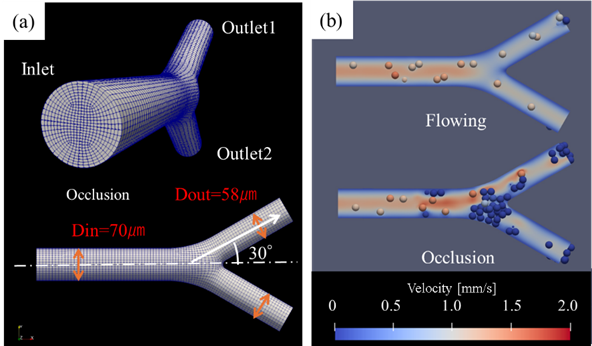Master student
mechanical system course, system design department
Tokyo Metropolitan University
Numerical and experimental analysis of vessel occlusion to evaluate optimal cell injection methods
Yoshiki Motegi1, Akari Misawa1, Van L Nguyen1, Hiromichi Obara1.
1Department of Mechanical System Engineering, Tokyo Metropolitan University, 1-1MInami-Osawa, Hachioji, Tokyo, Japan
Introduction: Cell injections into organs via the blood vessel have already been used in hepatocyte transplantation and islet transplantation to maintain organ function. Furthermore, organ fabrication using decellularized organs has the potential to solve the donor shortages. However, optimal methods have not been established to prevent the vascular occlusion that occurs during the cell injection process. In this study, we elucidate the mechanisms of vascular occlusion during cell injection via the blood vessels with numerical and experimental analysis. Furthermore, we propose optimal injection methods that don’t occur the vascular occlusion.
Methods: A single vascular bifurcation and cells were modeled as a Y-shaped circular channel and spherical particles. In numerical simulation CFD-DEM (Computational Fluid Dynamics–Discrete Element Method) coupling method was used (Fig.1). And the behavior of the fluid and particles imitated injected cells were simulated by solving the Navier–Stokes equations and the continuity equation for the fluid, and the translational and rotational equations of motion for the particles. The velocity profile and viscosity of the suspension fluid were adjusted to pulsatile flow. In the suspension injection experiments, fluorescent particles or cells were injected into a Y-shaped microchannel using a syringe pump. The flow within the channel was recorded by a zoom lens (L-773, HOZAN) and a high-speed camera (Model V-1015, nac) and quantified with image analysis.
Results: In the CFD-DEM coupled analysis, the time at which the number of particles flowing into the downstream branch ceased to increase was estimated as the time of occlusion. And it was accompanied by an increase in pressure. In the suspension injection experiments, particles came to rest and accumulated on the channel wall near the bifurcation, leading to occlusion. This suggested that particle adhesion to the channel wall contributes to the onset of occlusion.

Conclusion: To establish optimal cell injection methods, vascular occlusion was quantified, and its mechanism was elucidated using numerical analysis and experimental methods.
References:
[1] Cell transplantation
[2] Recellularization
[3] Vessel occlusion
[4] CFD (Computational fluid dynamics)
Lectures by Yoshiki Motegi
| When | Session | Talk Title | Room |
|---|---|---|---|
|
Fri-24 11:30 - 12:30 |
Parallel Session 12: From cell injection to tissue engineering | Numerical and experimental analysis of vessel occlusion to evaluate optimal cell injection methods | Main Hall |
